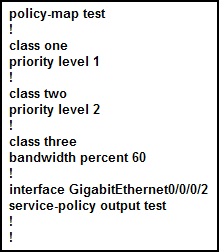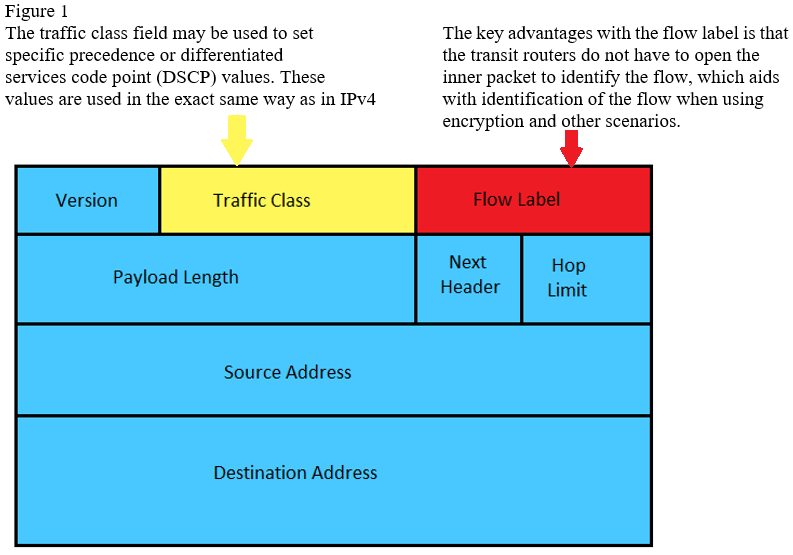Cisco® 642-887 Exam Practice Questions (P. 3)
- Full Access (183 questions)
- Six months of Premium Access
- Access to one million comments
- Seamless ChatGPT Integration
- Ability to download PDF files
- Anki Flashcard files for revision
- No Captcha & No AdSense
- Advanced Exam Configuration
Question #11
Refer to the Cisco IOS XR policy-map configuration exhibit.

What is wrong with the policy-map configuration?

What is wrong with the policy-map configuration?
- Amissing the priority percent command under class one and class two
- Bmissing the police command under class one and class two
- Cmissing the police command under class three
- Dmissing the priority bandwidth command under class one and class two
- Emissing the bandwidth command under class one and class two
Correct Answer:
B
Hierarchical policing is also supported. In such a configuration, both parent and child policies have class-maps containing policing statements, as in the following example:
!
policy-map child
class gold
police rate percent 50 conform-action set precedence immediate exceed-action drop
!
!
policy-map parent
class match_all
police rate 10000 kbps burst 15000 exceed-action drop
service-policy child
B
Hierarchical policing is also supported. In such a configuration, both parent and child policies have class-maps containing policing statements, as in the following example:
!
policy-map child
class gold
police rate percent 50 conform-action set precedence immediate exceed-action drop
!
!
policy-map parent
class match_all
police rate 10000 kbps burst 15000 exceed-action drop
service-policy child
send
light_mode
delete
Question #12
When configuring class-based WRED on Cisco routers, which WRED parameter is not user configurable on a Cisco IOS XR but is user configurable on a Cisco
IOS and IOS XE?
IOS and IOS XE?
- Athe ingress or egress direction where the class-based WRED policy will be applied
- Bthe maximum threshold
- Cthe minimum threshold
- Dthe mark probability denominator
Correct Answer:
D
Comparison of Cisco IOS QoS and Cisco IOS-XR QoS
The Cisco IOS-XR software implementation of QoS is basically the same as the QoS implementation on Cisco
IOS software, with the following exceptions:
On Cisco IOS-XR software, the bandwidth command can be configured only in egress policies.
The following changes have been made to the class-map command on Cisco IOS-XR software:
Supports 4K per logical router.
Maximum number of match criteria configurable in one class map is eight.
When a class is marked as high priority using the priority command on Cisco IOS-XR software, we recommend that you configure a policer to limit the priority traffic. Limiting the priority traffic will ensure that the priority traffic does not starve all of the other traffic on the line card. Use the police command to explicitly configure the policer.
On Cisco IO-XR software, only one conform-action, exceed-action, or violate-action command can be configured at a time. To configure traffic policing, use the police command.
On Cisco IOS-XR software, policy modifications cannot be made on existing policies. Use the policy-map command to remove the policy from all attached interfaces, delete the policy map, and redefine a new policy.
When configuring a policy map on Cisco IOS-XR software, the maximum number of classes configurable in one policy map is 16, which includes both Level 1 and
Level 2 classes. To configure a policy map, use the policy-map command.
When WRED is configured on Cisco IOS-XR software, the mark probability in the random-detect command is not configurableit is always set to 1.
When the random-detect exp command is used on Cisco IOS-XR software, the exponential weighting constant is not configurable and will be programmed automatically by Cisco IOS-XR software.
When access control lists (ACLs) are used in QoS class maps, the underlying deny or permit actions associated with access control entries (ACEs) are ignored.
ACEs are used as a classification mechanism in order to provide appropriate QoS behavior as specified in class maps. Use ACLs that include ACEs with permit actions only.
D
Comparison of Cisco IOS QoS and Cisco IOS-XR QoS
The Cisco IOS-XR software implementation of QoS is basically the same as the QoS implementation on Cisco
IOS software, with the following exceptions:
On Cisco IOS-XR software, the bandwidth command can be configured only in egress policies.
The following changes have been made to the class-map command on Cisco IOS-XR software:
Supports 4K per logical router.
Maximum number of match criteria configurable in one class map is eight.
When a class is marked as high priority using the priority command on Cisco IOS-XR software, we recommend that you configure a policer to limit the priority traffic. Limiting the priority traffic will ensure that the priority traffic does not starve all of the other traffic on the line card. Use the police command to explicitly configure the policer.
On Cisco IO-XR software, only one conform-action, exceed-action, or violate-action command can be configured at a time. To configure traffic policing, use the police command.
On Cisco IOS-XR software, policy modifications cannot be made on existing policies. Use the policy-map command to remove the policy from all attached interfaces, delete the policy map, and redefine a new policy.
When configuring a policy map on Cisco IOS-XR software, the maximum number of classes configurable in one policy map is 16, which includes both Level 1 and
Level 2 classes. To configure a policy map, use the policy-map command.
When WRED is configured on Cisco IOS-XR software, the mark probability in the random-detect command is not configurableit is always set to 1.
When the random-detect exp command is used on Cisco IOS-XR software, the exponential weighting constant is not configurable and will be programmed automatically by Cisco IOS-XR software.
When access control lists (ACLs) are used in QoS class maps, the underlying deny or permit actions associated with access control entries (ACEs) are ignored.
ACEs are used as a classification mechanism in order to provide appropriate QoS behavior as specified in class maps. Use ACLs that include ACEs with permit actions only.
send
light_mode
delete
Question #13
Which of the following three statements are correct regarding IPv6 QoS? (Choose three.)
- AThe traffic class field in the IPv6 header can be used to set specific precedence or DSCP values.
- BA 20-bit flow label field enables per-flow processing.
- CDS-TE is not supported by IPv6.
- DPer-hop behavior in IPv6 networks is based on EXP bits.
- EIPv6 QoS features are configured using the modular QoS CLI on Cisco routers.
Correct Answer:
ABE
http://www.cisco.com/en/US/technologies/tk648/tk872/technologies_white_paper0900aecd8026004d.pdf
Cisco Systems. IPv6 QoS
AT-A-GLANCE -
RFC 2460/3697 -
Currently IPv6 provides support for QoS marking via a field in the IPv6 header.
Similar to the type of service (ToS) field in the IPv4 header, the traffic class field (8 bits) is available for use by originating nodes and for forwarding routers to identify and distinguish between different classes or priorities of IPv6 packets.

Current Cisco IOS Software support for IPv6 QoS includes:
✑ Packet classification
✑ Queuing (includes LLQ; excludes legacy PQ/CQ)
✑ Traffic shaping
✑ WRED
IPv6 also has a 20-bit field known as the flow label field (RFC 3697). The flow label enables per flow processing for differentiation at the IP layer.
It can be used for special sender requests and is set by the source node.
The flow label must be modified by an intermediate mode.
Planned Cisco IOS Software support for IPv6 QoS includes:
✑ Compressed Real-Time Protocol (cRTP)
✑ Network-based application recognition (NBAR)
Committed access rate (CAR)

ABE
http://www.cisco.com/en/US/technologies/tk648/tk872/technologies_white_paper0900aecd8026004d.pdf
Cisco Systems. IPv6 QoS
AT-A-GLANCE -
RFC 2460/3697 -
Currently IPv6 provides support for QoS marking via a field in the IPv6 header.
Similar to the type of service (ToS) field in the IPv4 header, the traffic class field (8 bits) is available for use by originating nodes and for forwarding routers to identify and distinguish between different classes or priorities of IPv6 packets.

Current Cisco IOS Software support for IPv6 QoS includes:
✑ Packet classification
✑ Queuing (includes LLQ; excludes legacy PQ/CQ)
✑ Traffic shaping
✑ WRED
IPv6 also has a 20-bit field known as the flow label field (RFC 3697). The flow label enables per flow processing for differentiation at the IP layer.
It can be used for special sender requests and is set by the source node.
The flow label must be modified by an intermediate mode.
Planned Cisco IOS Software support for IPv6 QoS includes:
✑ Compressed Real-Time Protocol (cRTP)
✑ Network-based application recognition (NBAR)
Committed access rate (CAR)

send
light_mode
delete
Question #14
With unmanaged CE routers, at which point in the service provider network is the QoS trust boundary, and what is required at the trust boundary?
- Abetween the CE and PE router and mapping of the customer traffic classes into the service provider traffic classes at the PE router ingress
- Bbetween the CE and PE router and trusting the QoS markings from the CE router and applying the required QoS mechanisms based on the customer QoS markings
- Cbetween the PE and the P router and mapping of the customer traffic classes into the service provider traffic classes at the P router ingress
- Dbetween the PE and P router and trusting the QoS markings from the CE router and applying the required QoS mechanisms based on the customer QoS markings
- Ebetween the customer network and the CE router ingress and applying the required egress QoS policy on the CE router
Correct Answer:
A
A
send
light_mode
delete
Question #15
On the Cisco IOS XR, when using the match protocol command within a class-map to classify traffic, you noticed that the match protocol option on the Cisco IOS
XR shows much fewer protocol options than on the Cisco IOS or IOS XE, like there is no option such as the match protocol yahoo-messenger command on the
Cisco IOS XR. Why is this?
XR shows much fewer protocol options than on the Cisco IOS or IOS XE, like there is no option such as the match protocol yahoo-messenger command on the
Cisco IOS XR. Why is this?
- Abecause the Cisco IOS XR router does not have the correct software packages installed
- Bbecause when defining the class-map, the class-map type should be set to type inspect: class-map type inspect class-map-name command
- Cbecause NBAR is not supported on the Cisco IOS XR
- Dbecause flexible packet matching has not been enabled on the Cisco IOS XR router
Correct Answer:
C
C
send
light_mode
delete
All Pages
